Separation and evaluation of natural antileishmanial potential against Leishmania major and infuntum isolated from the Tunisia strains
DOI:
https://doi.org/10.3329/bjp.v13i1.33908Keywords:
Antileishmanial, Leishmania infuntum, Leishmania majorAbstract
Besides its nutritional value as a dietary supplement, Tribulus terrestris is used as a remedy for fertility disorder in Ayurveda and Chinese medicine as well as by modern herbalists. The aim of this study was to explore the biological potential (antileishmanial effect) of an extract rich in saponins from Tunisian tribulus. The chloroform extract of the various parts of T. terrestris was subjected to partial purification by solvent partitioning with ethanol and n-butanol. All prepared extracts were tested for their anti-leishmanial activity. The result showed that n-butanolic extract (saponin fraction, when isolated from leaves part) exhibited the best antileishmanial effect against both pathogenic parasites Leshmania L. major (GlC94) and L. infuntum (LV50) evaluated in vitro assessment through MTT assay. n-Butanolic extract had been detected, quantified and purified using the RP-HPLC finger print (Hypersil ODS coupled to UV-vis). High peak area (5116.82 at 3.03 min) was detected at 205 nm.
Downloads
151
163 Read
37

Published
How to Cite
Issue
Section
License
Authors who publish with this journal agree to the following terms:
- Authors retain copyright and grant the journal right of first publication with the work simultaneously licensed under a Creative Commons Attribution License that allows others to share the work with an acknowledgement of the work's authorship and initial publication in this journal.
- Authors are able to enter into separate, additional contractual arrangements for the non-exclusive distribution of the journal's published version of the work (e.g., post it to an institutional repository or publish it in a book), with an acknowledgement of its initial publication in this journal.
- Authors are permitted and encouraged to post their work online (e.g., in institutional repositories or on their website) prior to and during the submission process, as it can lead to productive exchanges, as well as earlier and greater citation of published work (See The Effect of Open Access).
